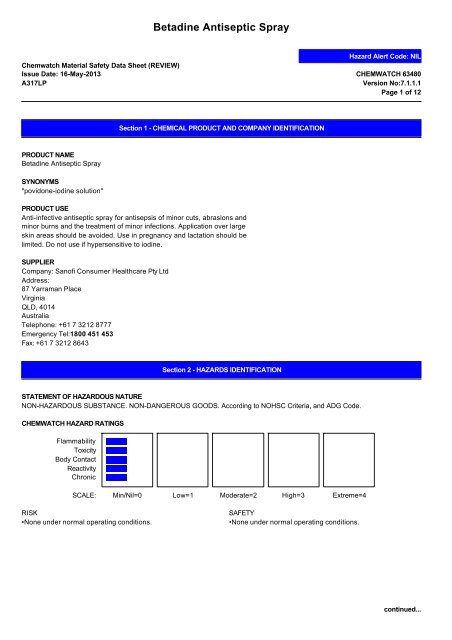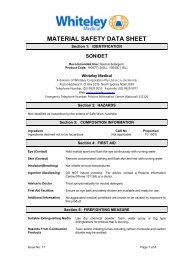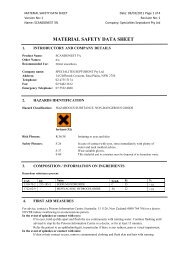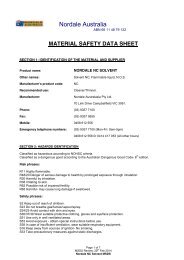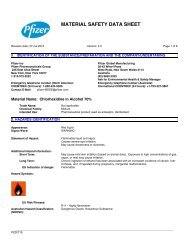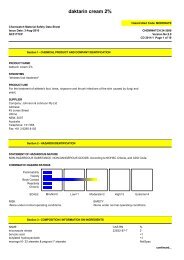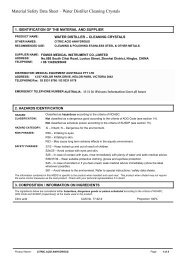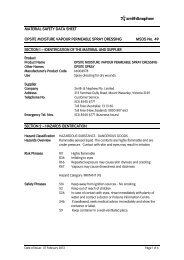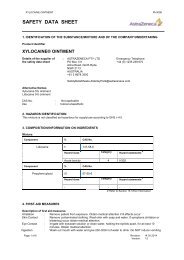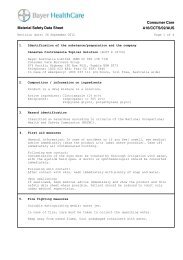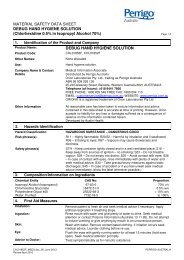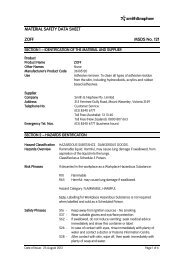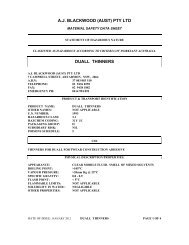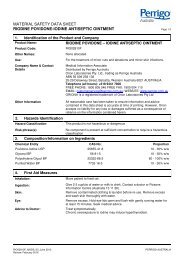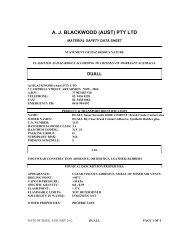Betadine Antiseptic Spray - Briggate Medical Company
Betadine Antiseptic Spray - Briggate Medical Company
Betadine Antiseptic Spray - Briggate Medical Company
You also want an ePaper? Increase the reach of your titles
YUMPU automatically turns print PDFs into web optimized ePapers that Google loves.
<strong>Betadine</strong> <strong>Antiseptic</strong> <strong>Spray</strong><br />
Hazard Alert Code: NIL<br />
Chemwatch Material Safety Data Sheet (REVIEW)<br />
Issue Date: 16-May-2013 CHEMWATCH 63480<br />
A317LP<br />
Version No:7.1.1.1<br />
Page 1 of 12<br />
Section 1 - CHEMICAL PRODUCT AND COMPANY IDENTIFICATION<br />
PRODUCT NAME<br />
<strong>Betadine</strong> <strong>Antiseptic</strong> <strong>Spray</strong><br />
SYNONYMS<br />
"povidone-iodine solution"<br />
PRODUCT USE<br />
Anti-infective antiseptic spray for antisepsis of minor cuts, abrasions and<br />
minor burns and the treatment of minor infections. Application over large<br />
skin areas should be avoided. Use in pregnancy and lactation should be<br />
limited. Do not use if hypersensitive to iodine.<br />
SUPPLIER<br />
<strong>Company</strong>: Sanofi Consumer Healthcare Pty Ltd<br />
Address:<br />
87 Yarraman Place<br />
Virginia<br />
QLD, 4014<br />
Australia<br />
Telephone: +61 7 3212 8777<br />
Emergency Tel:1800 451 453<br />
Fax: +61 7 3212 8643<br />
Section 2 - HAZARDS IDENTIFICATION<br />
STATEMENT OF HAZARDOUS NATURE<br />
NON-HAZARDOUS SUBSTANCE. NON-DANGEROUS GOODS. According to NOHSC Criteria, and ADG Code.<br />
CHEMWATCH HAZARD RATINGS<br />
Flammability<br />
Toxicity<br />
Body Contact<br />
Reactivity<br />
Chronic<br />
SCALE: Min/Nil=0 Low=1 Moderate=2 High=3 Extreme=4<br />
RISK<br />
•None under normal operating conditions.<br />
SAFETY<br />
•None under normal operating conditions.<br />
continued...
<strong>Betadine</strong> <strong>Antiseptic</strong> <strong>Spray</strong><br />
Hazard Alert Code: NIL<br />
Chemwatch Material Safety Data Sheet (REVIEW)<br />
Issue Date: 16-May-2013 CHEMWATCH 63480<br />
A317LP<br />
Version No:7.1.1.1<br />
Page 2 of 12<br />
Section 3 - COMPOSITION / INFORMATION ON INGREDIENTS<br />
NAME CAS RN %<br />
iodophore, as 5<br />
povidone- iodine 25655-41-8<br />
glycerol 56-81-5
<strong>Betadine</strong> <strong>Antiseptic</strong> <strong>Spray</strong><br />
Hazard Alert Code: NIL<br />
Chemwatch Material Safety Data Sheet (REVIEW)<br />
Issue Date: 16-May-2013 CHEMWATCH 63480<br />
A317LP<br />
Version No:7.1.1.1<br />
Page 3 of 12<br />
Section 5 - FIRE FIGHTING MEASURES<br />
• Equipment should be thoroughly decontaminated after use.<br />
FIRE/EXPLOSION HAZARD<br />
• Non combustible.<br />
• Not considered a significant fire risk, however containers may burn.<br />
FIRE INCOMPATIBILITY<br />
■ None known.<br />
HAZCHEM<br />
None<br />
Section 6 - ACCIDENTAL RELEASE MEASURES<br />
MINOR SPILLS<br />
• Clean up all spills immediately.<br />
• Avoid breathing vapours and contact with skin and eyes.<br />
• Control personal contact with the substance, by using protective equipment.<br />
• Contain and absorb spill with sand, earth, inert material or vermiculite.<br />
• Wipe up.<br />
• Place in a suitable, labelled container for waste disposal.<br />
MAJOR SPILLS<br />
Minor hazard.<br />
• Clear area of personnel.<br />
• Alert Fire Brigade and tell them location and nature of hazard.<br />
• Control personal contact with the substance, by using protective equipment as required.<br />
• Prevent spillage from entering drains or water ways.<br />
• Contain spill with sand, earth or vermiculite.<br />
• Collect recoverable product into labelled containers for recycling.<br />
• Absorb remaining product with sand, earth or vermiculite and place in appropriate containers for disposal.<br />
• Wash area and prevent runoff into drains or waterways.<br />
• If contamination of drains or waterways occurs, advise emergency services.<br />
Personal Protective Equipment advice is contained in Section 8 of the MSDS.<br />
Section 7 - HANDLING AND STORAGE<br />
PROCEDURE FOR HANDLING<br />
• Limit all unnecessary personal contact.<br />
• Wear protective clothing when risk of exposure occurs.<br />
• Use in a well-ventilated area.<br />
• Avoid contact with incompatible materials.<br />
• When handling, DO NOT eat, drink or smoke.<br />
• Keep containers securely sealed when not in use.<br />
• Avoid physical damage to containers.<br />
• Always wash hands with soap and water after handling.<br />
• Work clothes should be laundered separately.<br />
• Use good occupational work practice.<br />
continued...
<strong>Betadine</strong> <strong>Antiseptic</strong> <strong>Spray</strong><br />
Hazard Alert Code: NIL<br />
Chemwatch Material Safety Data Sheet (REVIEW)<br />
Issue Date: 16-May-2013 CHEMWATCH 63480<br />
A317LP<br />
Version No:7.1.1.1<br />
Page 4 of 12<br />
Section 7 - HANDLING AND STORAGE<br />
• Observe manufacturer's storage and handling recommendations contained within this MSDS.<br />
• Atmosphere should be regularly checked against established exposure standards to ensure safe working<br />
conditions are maintained.<br />
SUITABLE CONTAINER<br />
• Polyethylene or polypropylene container.<br />
• Packing as recommended by manufacturer.<br />
• Check all containers are clearly labelled and free from leaks.<br />
STORAGE INCOMPATIBILITY<br />
Avoid contamination of water, foodstuffs, feed or seed.<br />
None known.<br />
STORAGE REQUIREMENTS<br />
• Store in original containers.<br />
• Keep containers securely sealed.<br />
• Store in a cool, dry, well-ventilated area.<br />
• Store away from incompatible materials and foodstuff containers.<br />
• Protect containers against physical damage and check regularly for leaks.<br />
• Observe manufacturer's storage and handling recommendations contained within this MSDS.<br />
_____________________________________________________<br />
SAFE STORAGE WITH OTHER CLASSIFIED CHEMICALS<br />
+ + + + X +<br />
_____________________________________________________<br />
+: May be stored together<br />
O: May be stored together with specific preventions<br />
X: Must not be stored together<br />
Section 8 - EXPOSURE CONTROLS / PERSONAL PROTECTION<br />
EXPOSURE CONTROLS<br />
The following materials had no OELs on our records<br />
• povidone- iodine: CAS:25655- 41- 8<br />
• water: CAS:7732- 18- 5<br />
MATERIAL DATA<br />
BETADINE ANTISEPTIC SPRAY:<br />
None assigned. Refer to individual constituents.<br />
POVIDONE-IODINE:<br />
It is the goal of the ACGIH (and other Agencies) to recommend TLVs (or their equivalent) for all<br />
substances for which there is evidence of health effects at airborne concentrations encountered in the<br />
workplace.<br />
At this time no TLV has been established, even though this material may produce adverse health effects (as<br />
evidenced in animal experiments or clinical experience). Airborne concentrations must be maintained as low as<br />
is practically possible and occupational exposure must be kept to a minimum.<br />
NOTE: The ACGIH occupational exposure standard for Particles Not Otherwise Specified (P.N.O.S) does NOT<br />
continued...
<strong>Betadine</strong> <strong>Antiseptic</strong> <strong>Spray</strong><br />
Hazard Alert Code: NIL<br />
Chemwatch Material Safety Data Sheet (REVIEW)<br />
Issue Date: 16-May-2013 CHEMWATCH 63480<br />
A317LP<br />
Version No:7.1.1.1<br />
Page 5 of 12<br />
Section 8 - EXPOSURE CONTROLS / PERSONAL PROTECTION<br />
apply.<br />
GLYCEROL:<br />
Sensory irritants are chemicals that produce temporary and undesirable side-effects on the eyes, nose or<br />
throat. Historically occupational exposure standards for these irritants have been based on observation of<br />
workers' responses to various airborne concentrations. Present day expectations require that nearly every<br />
individual should be protected against even minor sensory irritation and exposure standards are established<br />
using uncertainty factors or safety factors of 5 to 10 or more. On occasion animal no-observable-effectlevels<br />
(NOEL) are used to determine these limits where human results are unavailable. An additional approach,<br />
typically used by the TLV committee (USA) in determining respiratory standards for this group of chemicals,<br />
has been to assign ceiling values (TLV C) to rapidly acting irritants and to assign short-term exposure<br />
limits (TLV STELs) when the weight of evidence from irritation, bioaccumulation and other endpoints combine<br />
to warrant such a limit. In contrast the MAK Commission (Germany) uses a five-category system based on<br />
intensive odour, local irritation, and elimination half-life. However this system is being replaced to be<br />
consistent with the European Union (EU) Scientific Committee for Occupational Exposure Limits (SCOEL); this<br />
is more closely allied to that of the USA.<br />
OSHA (USA) concluded that exposure to sensory irritants can:<br />
• cause inflammation<br />
• cause increased susceptibility to other irritants and infectious agents<br />
• lead to permanent injury or dysfunction<br />
• permit greater absorption of hazardous substances and<br />
• acclimate the worker to the irritant warning properties of these substances thus increasing the risk of<br />
overexposure.<br />
The mist is considered to be a nuisance particulate which appears to have little adverse effect on the<br />
lung and does not produce significant organic disease or toxic effects. OSHA concluded that the nuisance<br />
particulate limit would protect the worker form kidney damage and perhaps, testicular effects.<br />
WATER:<br />
No exposure limits set by NOHSC or ACGIH.<br />
PERSONAL PROTECTION<br />
EYE<br />
• Safety glasses with side shields<br />
• Chemical goggles.<br />
• Contact lenses may pose a special hazard; soft contact lenses may absorb and concentrate irritants. A<br />
written policy document, describing the wearing of lens or restrictions on use, should be created for each<br />
workplace or task. This should include a review of lens absorption and adsorption for the class of<br />
chemicals in use and an account of injury experience. <strong>Medical</strong> and first-aid personnel should be trained in<br />
their removal and suitable equipment should be readily available. In the event of chemical exposure, begin<br />
eye irrigation immediately and remove contact lens as soon as practicable. Lens should be removed at the<br />
first signs of eye redness or irritation - lens should be removed in a clean environment only after workers<br />
have washed hands thoroughly. [CDC NIOSH Current Intelligence Bulletin 59], [AS/NZS 1336 or national<br />
equivalent].<br />
continued...
<strong>Betadine</strong> <strong>Antiseptic</strong> <strong>Spray</strong><br />
Hazard Alert Code: NIL<br />
Chemwatch Material Safety Data Sheet (REVIEW)<br />
Issue Date: 16-May-2013 CHEMWATCH 63480<br />
A317LP<br />
Version No:7.1.1.1<br />
Page 6 of 12<br />
Section 8 - EXPOSURE CONTROLS / PERSONAL PROTECTION<br />
HANDS/FEET<br />
■ Wear general protective gloves, eg. light weight rubber gloves.<br />
The selection of the suitable gloves does not only depend on the material, but also on further marks of<br />
quality which vary from manufacturer to manufacturer. Where the chemical is a preparation of several<br />
substances, the resistance of the glove material can not be calculated in advance and has therefore to be<br />
checked prior to the application.<br />
The exact break through time for substances has to be obtained from the manufacturer of the protective gloves<br />
and<br />
has to be observed when making a final choice.<br />
Suitability and durability of glove type is dependent on usage. Important factors in the selection of gloves<br />
include:<br />
• frequency and duration of contact,<br />
• chemical resistance of glove material,<br />
• glove thickness and<br />
• dexterity<br />
Select gloves tested to a relevant standard (e.g. Europe EN 374, US F739, AS/NZS 2161.1 or national<br />
equivalent).<br />
• When prolonged or frequently repeated contact may occur, a glove with a protection class of 5 or higher<br />
(breakthrough time greater than 240 minutes according to EN 374, AS/NZS 2161.10.1 or national equivalent)<br />
is recommended.<br />
• When only brief contact is expected, a glove with a protection class of 3 or higher (breakthrough time<br />
greater than 60 minutes according to EN 374, AS/NZS 2161.10.1 or national equivalent) is recommended.<br />
• Contaminated gloves should be replaced.<br />
Gloves must only be worn on clean hands. After using gloves, hands should be washed and dried thoroughly.<br />
Application of a non-perfumed moisturiser is recommended.<br />
OTHER<br />
■ No special equipment needed when handling small quantities.<br />
OTHERWISE:<br />
• Overalls.<br />
• Barrier cream.<br />
• Eyewash unit.<br />
GLOVE SELECTION INDEX<br />
■ Glove selection is based on a modified presentation of the:<br />
" Forsberg Clothing Performance Index" .<br />
The effect(s) of the following substance(s) are taken into account in the<br />
computer- generated selection: water, glycerol<br />
■ Protective Material CPI *.<br />
____________________________________________<br />
NATURAL RUBBER<br />
C<br />
____________________________________________<br />
■ * CPI - Chemwatch Performance Index<br />
A: Best Selection<br />
B: Satisfactory; may degrade after 4 hours continuous immersion<br />
C: Poor to Dangerous Choice for other than short term immersion<br />
NOTE: As a series of factors will influence the actual performance of the glove, a final selection must be<br />
based on detailed observation. -<br />
* Where the glove is to be used on a short term, casual or infrequent basis, factors such as "feel" or<br />
convenience (e.g. disposability), may dictate a choice of gloves which might otherwise be unsuitable<br />
following long-term or frequent use. A qualified practitioner should be consulted.<br />
continued...
<strong>Betadine</strong> <strong>Antiseptic</strong> <strong>Spray</strong><br />
Hazard Alert Code: NIL<br />
Chemwatch Material Safety Data Sheet (REVIEW)<br />
Issue Date: 16-May-2013 CHEMWATCH 63480<br />
A317LP<br />
Version No:7.1.1.1<br />
Page 7 of 12<br />
Section 8 - EXPOSURE CONTROLS / PERSONAL PROTECTION<br />
RESPIRATOR<br />
•Type A-P Filter of sufficient capacity. (AS/NZS 1716 & 1715, EN 143:2000 & 149:2001, ANSI Z88 or national<br />
equivalent)<br />
The local concentration of material, quantity and conditions of use determine the type of personal protective<br />
equipment required. For further information consult site specific CHEMWATCH data (if available), or your<br />
Occupational Health and Safety Advisor.<br />
ENGINEERING CONTROLS<br />
■ Engineering controls are used to remove a hazard or place a barrier between the worker and the hazard. Welldesigned<br />
engineering controls can be highly effective in protecting workers and will typically be independent<br />
of worker interactions to provide this high level of protection.<br />
The basic types of engineering controls are:<br />
Process controls which involve changing the way a job activity or process is done to reduce the risk.<br />
Enclosure and/or isolation of emission source which keeps a selected hazard "physically" away from the worker<br />
and ventilation that strategically "adds" and "removes" air in the work environment. Ventilation can remove<br />
or dilute an air contaminant if designed properly. The design of a ventilation system must match the<br />
particular process and chemical or contaminant in use.<br />
Employers may need to use multiple types of controls to prevent employee overexposure.<br />
General exhaust is adequate under normal operating conditions. If risk of overexposure exists, wear SAA<br />
approved respirator. Correct fit is essential to obtain adequate protection. Provide adequate ventilation in<br />
warehouse or closed storage areas.<br />
Section 9 - PHYSICAL AND CHEMICAL PROPERTIES<br />
APPEARANCE<br />
Clear dark brown liquid with a slight odour of iodine; mixes with water.<br />
PHYSICAL PROPERTIES<br />
Liquid.<br />
Mixes with water.<br />
State Liquid Molecular Weight Not Applicable<br />
Melting Range (°C) Not Available Viscosity Not Available<br />
Boiling Range (°C) Not Available Solubility in water (g/L) Miscible<br />
Flash Point (°C) Not Applicable pH (1% solution) Not Available<br />
Decomposition Temp (°C) Not Available pH (as supplied) Not Available<br />
Autoignition Temp (°C) Not Applicable Vapour Pressure (kPa) Not Available<br />
Upper Explosive Limit (%) Not Applicable Specific Gravity (water=1) 1.03 approx.<br />
Lower Explosive Limit (%) Not Applicable Relative Vapour Density Not Available<br />
(air=1)<br />
Volatile Component (%vol) Not Available Evaporation Rate Not Available<br />
Section 10 - STABILITY AND REACTIVITY<br />
CONDITIONS CONTRIBUTING TO INSTABILITY<br />
■ Product is considered stable and hazardous polymerisation will not occur.<br />
For incompatible materials - refer to Section 7 - Handling and Storage.<br />
continued...
<strong>Betadine</strong> <strong>Antiseptic</strong> <strong>Spray</strong><br />
Hazard Alert Code: NIL<br />
Chemwatch Material Safety Data Sheet (REVIEW)<br />
Issue Date: 16-May-2013 CHEMWATCH 63480<br />
A317LP<br />
Version No:7.1.1.1<br />
Page 8 of 12<br />
Section 11 - TOXICOLOGICAL INFORMATION<br />
POTENTIAL HEALTH EFFECTS<br />
ACUTE HEALTH EFFECTS<br />
SWALLOWED<br />
■ The material has NOT been classified by EC Directives or other classification systems as "harmful by<br />
ingestion". This is because of the lack of corroborating animal or human evidence. The material may still be<br />
damaging to the health of the individual, following ingestion, especially where pre-existing organ (eg. liver,<br />
kidney) damage is evident. Present definitions of harmful or toxic substances are generally based on doses<br />
producing mortality rather than those producing morbidity (disease, ill-health). Gastrointestinal tract<br />
discomfort may produce nausea and vomiting. In an occupational setting however, ingestion of insignificant<br />
quantities is not thought to be cause for concern.<br />
EYE<br />
■ Although the liquid is not thought to be an irritant (as classified by EC Directives), direct contact with<br />
the eye may produce transient discomfort characterised by tearing or conjunctival redness (as with windburn).<br />
SKIN<br />
■ The material is not thought to produce adverse health effects or skin irritation following contact (as<br />
classified by EC Directives using animal models). Nevertheless, good hygiene practice requires that exposure<br />
be kept to a minimum and that suitable gloves be used in an occupational setting.<br />
INHALED<br />
■ The material is not thought to produce adverse health effects or irritation of the respiratory tract (as<br />
classified by EC Directives using animal models). Nevertheless, good hygiene practice requires that exposure<br />
be kept to a minimum and that suitable control measures be used in an occupational setting.<br />
Not normally a hazard due to non-volatile nature of product.<br />
CHRONIC HEALTH EFFECTS<br />
■ Long-term exposure to the product is not thought to produce chronic effects adverse to the health (as<br />
classified by EC Directives using animal models); nevertheless exposure by all routes should be minimised as<br />
a matter of course.<br />
TOXICITY AND IRRITATION<br />
■ unless otherwise specified data extracted from RTECS - Register of Toxic Effects of Chemical Substances.<br />
WATER:<br />
BETADINE ANTISEPTIC SPRAY:<br />
■ No significant acute toxicological data identified in literature search.<br />
POVIDONE-IODINE:<br />
TOXICITY<br />
IRRITATION<br />
Oral (rat) LD50:>8000 mg/k<br />
Skin (rabbit):500 mg Mild<br />
Oral (rat) LD50:5990 mg/kg * [* = Manufacturer]<br />
Dermal (human) TDLo:3400 mg/Kg/24h<br />
■ The material may cause skin irritation after prolonged or repeated exposure and may produce on contact skin<br />
redness, swelling, the production of vesicles, scaling and thickening of the skin.<br />
continued...
<strong>Betadine</strong> <strong>Antiseptic</strong> <strong>Spray</strong><br />
Hazard Alert Code: NIL<br />
Chemwatch Material Safety Data Sheet (REVIEW)<br />
Issue Date: 16-May-2013 CHEMWATCH 63480<br />
A317LP<br />
Version No:7.1.1.1<br />
Page 9 of 12<br />
Section 11 - TOXICOLOGICAL INFORMATION<br />
GLYCEROL:<br />
TOXICITY<br />
IRRITATION<br />
Oral (Rat) LD50:12600 mg/kg<br />
Oral (Guinea pig) LD50:7750 mg/kg<br />
Oral (Human) TDLo:1428 mg/kg<br />
Intraperitoneal (Rat) LD50:4420 mg/kg<br />
Subcutaneous (Rat) LD50:100 mg/kg<br />
Intravenous (Rat) LD50:5566 mg/kg<br />
Oral (Mouse) LD50:4090 mg/kg<br />
Intraperitoneal (Mouse) LD50:8700 mg/kg<br />
Subcutaneous (Mouse) LD50:91 mg/kg<br />
Intravenous (Mouse) LD50:4250 mg/kg<br />
■ At very high concentrations, evidence predicts that glycerol may cause tremor, irritation of the skin, eyes,<br />
digestive tract and airway. Otherwise it is of low toxicity. There is no significant evidence to suggest that<br />
it causes cancer, genetic, reproductive or developmental toxicity.<br />
SKIN<br />
glycerol GESAMP/EHS Composite List - GESAMP Hazard D1: skin 0<br />
Profiles<br />
irritation/corrosion<br />
GLYCEROL:<br />
POVIDONE-IODINE:<br />
DO NOT discharge into sewer or waterways.<br />
Section 12 - ECOLOGICAL INFORMATION<br />
POVIDONE-IODINE:<br />
For Iodine: Iodine is an important element in studies of environmental protection and human health, globalscale<br />
hydrologic processes and nuclear non-proliferation. Inorganic and organic species that may be<br />
hydrophilic, atmophilic, and biophilic.<br />
Terrestrial Fate: There was an appreciable iodate reduction to iodide, presumably mediated by the structural<br />
iron(II), in some clay minerals. Humic acid in soil promotes the electrochemical reduction of iodine(12) to<br />
ionic iodide. The different oxidation species of iodine have markedly different sorption properties, hence,<br />
changes in iodine redox states can greatly affect the mobility of iodine in the environment. Both soluble<br />
ferrous iron and sulfide, as well as iron monosulfide (FeS) were shown to abiologically reduce iodate to<br />
iodide. These results indicate that ferric iron and/or sulfate reducing bacteria are capable of mediating<br />
both direct, enzymatic, as well as abiotic reduction of iodate in natural anaerobic environments.<br />
Environmental and geological evidence indicates that iodine can become associated with natural organic matter<br />
(NOM) in soils and sediments. Iodine can be strongly retained in organic-rich surface soils and sediment.<br />
Soluble iodine may be associated with dissolved humic material. Iodine and iodate undergo a reaction with<br />
peat leading to either reduction of iodate or iodine to iodide or incorporation of the iodine atoms into the<br />
organic matrix. Iodine appears to be incorporated in sphagnum peat by aromatic substitution for hydrogen on<br />
phenolic constituents of the peat.<br />
GLYCEROL:<br />
Algae IC50 (72hr.) (mg/l): 2900- 10000<br />
log Kow (Sangster 1997): - 1.76<br />
log Pow (Verschueren 1983): 1.07692307<br />
BOD5: 51%<br />
COD: 95%<br />
continued...
<strong>Betadine</strong> <strong>Antiseptic</strong> <strong>Spray</strong><br />
Hazard Alert Code: NIL<br />
Chemwatch Material Safety Data Sheet (REVIEW)<br />
Issue Date: 16-May-2013 CHEMWATCH 63480<br />
A317LP<br />
Version No:7.1.1.1<br />
Page 10 of 12<br />
Section 12 - ECOLOGICAL INFORMATION<br />
ThOD: 93%<br />
For Glycerol: Log Kow: -2.66 to -2.47,<br />
Atmospheric Fate: Glycerol is broken down in the air by hydroxyl radicals – the half-life for this process is<br />
6.8 hours. However, only a negligible amount of the substance will move to the atmospheric compartment.<br />
Terrestrial Fate: Only a negligible amount of glycerol will move into the soil compartment, if released into<br />
the environment.<br />
Aquatic Fate: Glycerol is considered to be readily biodegradable in the aquatic environment. Pre-adapted<br />
microorganisms can break glycerol down rapidly in oxygenated/low oxygen waters. The substance is not expected<br />
to react with water. When released to water, 100% of the substance will remain in the water compartment -<br />
only negligible amounts will be distributed to sediment.<br />
Ecotoxicity: Glycerol is readily biodegradable. This substance is non-toxic to fish, including goldfish,<br />
algae, and bacteria, (Pseudomonas putida), and Daphnia magna water fleas. Glycerol is of low toxicity to<br />
aquatic organisms. Long-term aquatic toxicity data is not available. The substance is completely<br />
biodegradable and has a low potential to accumulate.<br />
Ecotoxicity<br />
Ingredient Persistence: Persistence: Air Bioaccumulation Mobility<br />
Water/Soil<br />
povidone- iodine No Data No Data No Data No Data<br />
Available Available Available Available<br />
glycerol LOW No Data LOW HIGH<br />
Available<br />
Section 13 - DISPOSAL CONSIDERATIONS<br />
Legislation addressing waste disposal requirements may differ by country, state and/ or territory. Each user<br />
must refer to laws operating in their area. In some areas, certain wastes must be tracked.<br />
A Hierarchy of Controls seems to be common - the user should investigate:<br />
• Reduction<br />
• Reuse<br />
• Recycling<br />
• Disposal (if all else fails)<br />
This material may be recycled if unused, or if it has not been contaminated so as to make it unsuitable for<br />
its intended use. If it has been contaminated, it may be possible to reclaim the product by filtration,<br />
distillation or some other means. Shelf life considerations should also be applied in making decisions of<br />
this type. Note that properties of a material may change in use, and recycling or reuse may not always be<br />
appropriate.<br />
• DO NOT allow wash water from cleaning or process equipment to enter drains.<br />
• It may be necessary to collect all wash water for treatment before disposal.<br />
• In all cases disposal to sewer may be subject to local laws and regulations and these should be considered<br />
first.<br />
• Where in doubt contact the responsible authority.<br />
• Recycle wherever possible.<br />
• Consult manufacturer for recycling options or consult local or regional waste management authority for<br />
disposal if no suitable treatment or disposal facility can be identified.<br />
• Dispose of by: burial in a land-fill specifically licenced to accept chemical and / or pharmaceutical<br />
wastes or incineration in a licenced apparatus (after admixture with suitable combustible material).<br />
• Decontaminate empty containers. Observe all label safeguards until containers are cleaned and destroyed.<br />
continued...
<strong>Betadine</strong> <strong>Antiseptic</strong> <strong>Spray</strong><br />
Hazard Alert Code: NIL<br />
Chemwatch Material Safety Data Sheet (REVIEW)<br />
Issue Date: 16-May-2013 CHEMWATCH 63480<br />
A317LP<br />
Version No:7.1.1.1<br />
Page 11 of 12<br />
Section 14 - TRANSPORTATION INFORMATION<br />
HAZCHEM:<br />
None (ADG7)<br />
NOT REGULATED FOR TRANSPORT OF DANGEROUS GOODS: ADG7, IATA, IMDG<br />
Section 15 - REGULATORY INFORMATION<br />
POISONS SCHEDULE<br />
None<br />
REGULATIONS<br />
Regulations for ingredients<br />
povidone-iodine (CAS: 25655-41-8) is found on the following regulatory lists;<br />
"Australia - Victoria Drugs, Poisons and Controlled Substances (Precursor Chemicals) Regs 2007 - Schedule 1 -<br />
Precursor Chemicals and Quantities", "Australia Illicit Drug Precursors/Reagents - Category II", "Australia<br />
Inventory of Chemical Substances (AICS)", "Australia National Pollutant Inventory", "FisherTransport<br />
Information"<br />
glycerol (CAS: 56-81-5) is found on the following regulatory lists;<br />
"Australia Exposure Standards", "Australia High Volume Industrial Chemical List (HVICL)", "Australia<br />
Inventory of Chemical Substances (AICS)", "Australia National Pollutant Inventory", "Australia Therapeutic<br />
Goods Administration (TGA) Substances that may be used as active ingredients in Listed medicines", "CODEX<br />
General Standard for Food Additives (GSFA) - Additives Permitted for Use in Food in General, Unless<br />
Otherwise Specified, in Accordance with GMP", "FisherTransport Information", "GESAMP/EHS Composite List -<br />
GESAMP Hazard Profiles", "IMO IBC Code Chapter 17: Summary of minimum requirements", "IMO IBC Code Chapter 18:<br />
List of products to which the Code does not apply", "IMO MARPOL 73/78 (Annex II) - List of Other Liquid<br />
Substances", "International Council of Chemical Associations (ICCA) - High Production Volume List",<br />
"International Fragrance Association (IFRA) Survey: Transparency List", "International Numbering System for<br />
Food Additives", "IOFI Global Reference List of Chemically Defined Substances", "OECD List of High Production<br />
Volume (HPV) Chemicals", "Sigma-AldrichTransport Information"<br />
water (CAS: 7732-18-5) is found on the following regulatory lists;<br />
"Australia High Volume Industrial Chemical List (HVICL)", "Australia Inventory of Chemical Substances (AICS)",<br />
"IMO IBC Code Chapter 18: List of products to which the Code does not apply", "International Fragrance<br />
Association (IFRA) Survey: Transparency List", "OECD List of High Production Volume (HPV) Chemicals", "OSPAR<br />
National List of Candidates for Substitution – Norway", "Sigma-AldrichTransport Information"<br />
No data for <strong>Betadine</strong> <strong>Antiseptic</strong> <strong>Spray</strong> (CW: 63480)<br />
Section 16 - OTHER INFORMATION<br />
■ Classification of the preparation and its individual components has drawn on official and authoritative<br />
sources as well as independent review by the Chemwatch Classification committee using available literature<br />
references.<br />
A list of reference resources used to assist the committee may be found at:<br />
continued...
<strong>Betadine</strong> <strong>Antiseptic</strong> <strong>Spray</strong><br />
Hazard Alert Code: NIL<br />
Chemwatch Material Safety Data Sheet (REVIEW)<br />
Issue Date: 16-May-2013 CHEMWATCH 63480<br />
A317LP<br />
Version No:7.1.1.1<br />
Page 12 of 12<br />
Section 16 - OTHER INFORMATION<br />
www.chemwatch.net/references.<br />
■ The (M)SDS is a Hazard Communication tool and should be used to assist in the Risk Assessment. Many factors<br />
determine whether the reported Hazards are Risks in the workplace or other settings. Risks may be determined<br />
by reference to Exposures Scenarios. Scale of use, frequency of use and current or available engineering<br />
controls must be considered.<br />
This document is copyright. Apart from any fair dealing for the purposes of private study, research, review or<br />
criticism, as permitted under the Copyright Act, no part may be reproduced by any process without written<br />
permission from CHEMWATCH. TEL (+61 3) 9572 4700.<br />
Issue Date: 16-May-2013<br />
Print Date: 7-Aug-2013<br />
This is the end of the MSDS.


